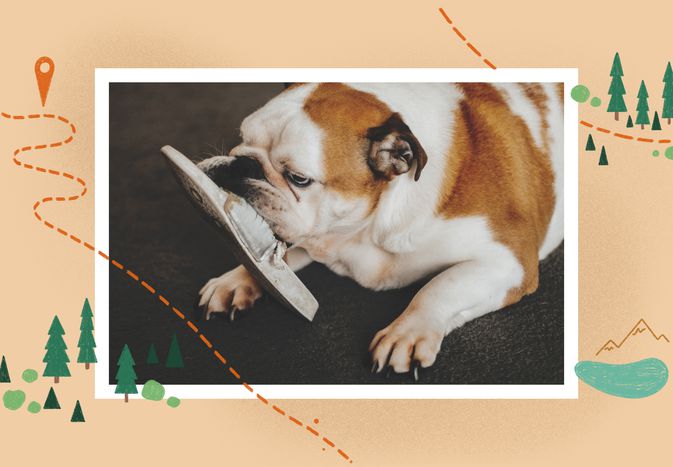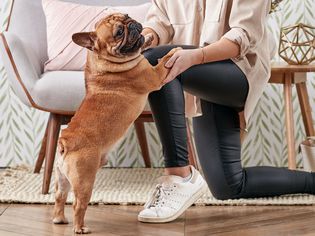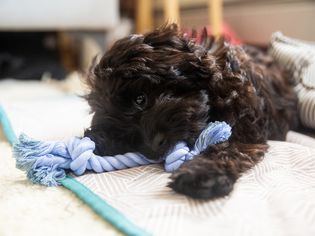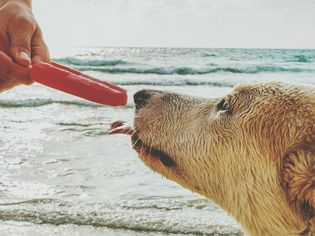Bringing a new dog home is exciting, but it’s not always the picture-perfect experience you envisioned. One day you’re gushing over how adorable they are, and the next, you’re surveying the damage after they’ve chewed through your couch or ripped apart your favorite shoes. It can be tough to not let your frustration take over in these moments, but staying calm is crucial for your pup’s well-being.
We talked with professional dog trainers for tips on how to keep your cool and effectively guide your pup toward better behavior when they inevitably destroy something in your home.
Why Do Dogs Destroy Things?
Dogs destroy things in our homes for various reasons, and it’s not always easy to pinpoint exactly why they used your coffee table’s leg as a chew toy. However, trying to understand the root cause can help you address the behavior more effectively. Here are some common reasons:
- Boredom: One of the most frequent causes of destructive behavior is boredom. When dogs don’t get enough mental or physical stimulation, they often turn to destructive activities to entertain themselves. A lack of toys, attention, or exercise can all contribute to this behavior.
- Separation anxiety: Many dogs experience anxiety when left alone for long periods, which can manifest in destructive behavior. Chewing or tearing things apart may be their way of coping with the stress and trying to self-soothe in your absence.
- Teething: For puppies, teething is a natural but uncomfortable process, and chewing helps to alleviate the discomfort. During this phase, puppies are more prone to destroy things, as their mouths explore the world around them.
- Instinctual behavior: Some dogs are simply following their instincts. Breeds with a strong prey drive, such as Jack Russell terriers, Yorkshire terriers, and dachshunds, might have a natural urge to tear things apart, as they would with prey in the wild.
- Seeking attention: Sometimes, dogs destroy things to get your attention. If they notice that chewing on your belongings results in you engaging with them, they may continue the behavior as a way to interact with you.
- Stress or frustration: Changes in routine, new environments, or even frustration with lack of access to certain areas can trigger destructive behaviors. Dogs may chew or destroy objects as a way to express their stress or frustration.
How to React When Your Dog Destroys Something
“Although for most of us the first impulse is to get upset with the dog, punishment or scolding isn’t the best response from a training standpoint,” says Rhiannon van Lidth de Jeude Roemer, KPA-CTP, dog trainer and events coordinator at Raintown Dog Training.
Here's what to do instead.
- Redirect their attention: If you catch your dog in the act, van Lidth de Jeude Roemer recommends staying calm and redirecting their focus to something appropriate, like a chew toy or a designated digging spot. This teaches them what behaviors are acceptable.
- Move them to another room before cleanup: Elisha Stynchula, CPDT-KA, CNWI, CTDI, FDM, dog trainer and owner of “I Said Sit!” School for Dogs, advises against letting your dog watch as you clean up a destroyed item. If they see you handling it, they might assume you’re playing with it, reinforcing the idea that chewing it is acceptable. To avoid this confusion, place your dog in another room while you clean up.
- Resist the urge to scold: According to van Lidth de Jeude Roemer, a harsh word might stop your pup from chewing the sofa or scratching the door if caught in the moment, but it’s unlikely to prevent the behavior in other situations, like when you're not around. Plus, it may make your dog anxious or fearful of you.
How to Train Your Dog Not To Destroy Things
Training your dog not to chew on inappropriate items can feel like an uphill battle, but with consistency, patience, and the right approach, you can help your dog learn what’s off-limits and what’s fair game. Here’s what to do:
- Provide plenty of interactive options: “First, you need to ensure your dog has plenty of ‘legal’ outlets for their natural behaviors, including high-value chew items, opportunities to dig, and mentally stimulating activities,” van Lidth de Jeude Roemer says. Teach them what they can play with and rotate their toys and activities regularly to keep them interested, she adds.
- Use positive reinforcement: When your dog chews on an appropriate item, reward them with praise, treats, or playtime. This helps reinforce the idea that chewing on their toys is a good thing.
- Supervise and manage: While your dog is still learning what’s off-limits, management is key. “Either keep the dog in a puppy-proofed pen/room/crate or block off their access to problem areas,” van Lidth de Jeude Roemer says. “We want to prevent the dog from rehearsing these unwanted behaviors.”
- Provide adequate exercise: A tired dog is a well-behaved dog (well, sometimes). Make sure your dog is getting enough exercise in the form of walks or playtime, Stynchula says. Puzzle toys, snuffle mats, and games like fetch or tug-of-war can also help burn off excess energy.
- Teach the “leave it” command: The “leave it” command is a valuable tool for preventing unwanted chewing. Practice this command with treats and toys, rewarding your dog when they respond correctly. Over time, this command can help you stop them from chewing inappropriate objects before it starts.
- Don’t give mixed signals: It’s important to be consistent with what your dog is allowed to chew. Avoid giving them old shoes, socks, or other household items to chew on, as this can confuse them. Your dog won’t know the difference between an old shoe and your new pair if they’ve been allowed to chew on similar items in the past.
By staying calm, understanding your dog’s needs, and focusing on consistent training, you can help guide your new pup toward better behavior and a happier home.








Comments on " How to Keep Your Cool If, or When, Your New Dog Destroys Your House" :